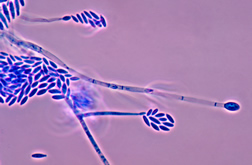This page has been archived and is being provided for reference purposes only. The page is no longer being updated, and therefore, links on the page may be invalid.
Read the magazine story to find out more. |
|
Scientists Pick Apart Fungus for Genetic Clues
By Jan SuszkiwOctober 5, 2006
Using the tools of molecular genetics, Agricultural Research Service (ARS) scientists are deconstructing the toxin-making machinery of the fungus Fusarium verticillioides to find clues to its contamination of corn.
Contamination of corn by fumonisin, a mycotoxin produced by the fungus, can diminish the quality and value of the kernels or render them unsafe to eat, according to David Kendra. He is a microbiologist at the ARS National Center for Agricultural Utilization Research (NCAUR) in Peoria, Ill.
There, Kendra and ARS research colleagues Daren Brown, Robert Butchko, Ronald Plattner and Robert Proctor are searching for genes that enable F. verticillioides to produce the mycotoxin, as well as to rot the ears and stalks of susceptible corn. Clues emerging from an examination of such genes and how they work in concert may reveal a chink in the fungus’ armor worth exploiting. One possibility is to formulate sprays that disrupt the fungus’ toxin synthesis, or perhaps its formation of critical spore pigments, according to Kendra, who oversees NCAUR’s Mycotoxin Research Unit.
First, though, Kendra’s team, together with collaborators from five other research institutions, must finish compiling the equivalent of “genetic snapshots” of the fungus. They want to capture them during particular fungal stages, such as while it’s germinating, spreading through the plant’s vascular system, or making fumonisin.
One high-tech tool used to do this is the microarray. It enables the detection of genetic activity in tiny snippets of ribonucleic acid material taken from the fungus. The work, begun in 2001, has led to the identification of nucleic acid sequences for 80 percent of F. verticillioides genes, Kendra reports.
Some early findings include microarray evidence that many of the same genes the fungus uses to infect field corn are also active during its attacks on sweet corn varieties. The scientists also identified a new fumonisin gene, FUM20, plus nine others that may regulate its synthesis, according to a more detailed story in the October 2006 issue of Agricultural Research magazine.
That issue highlights agency food safety research.
ARS is the U.S. Department of Agriculture’s chief scientific research agency.

